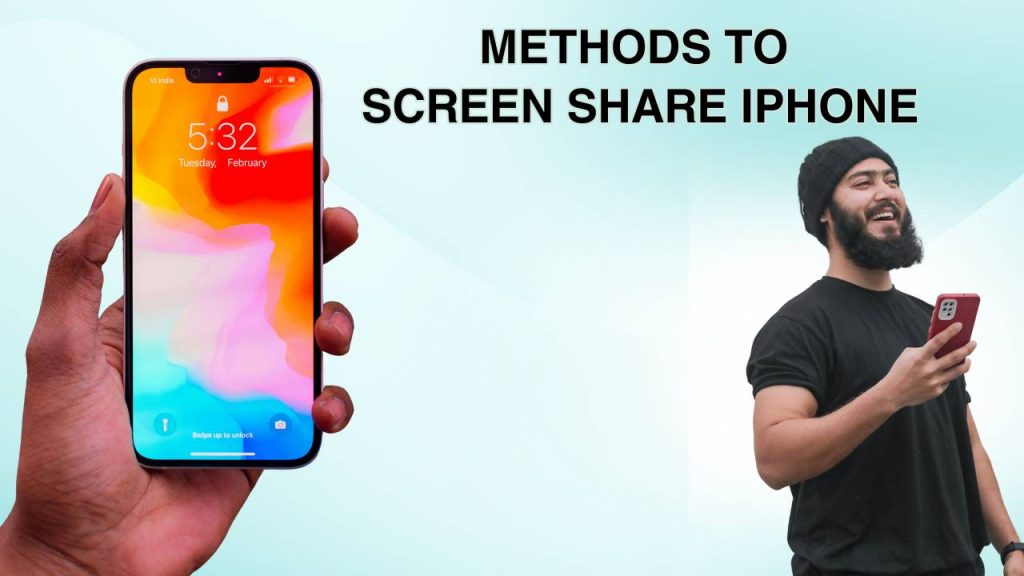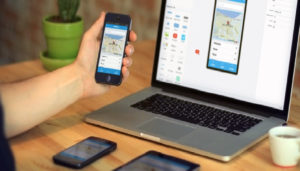Screen sharing is no longer just a feature — it’s a necessity in today’s tech-driven environment. Whether you’re a teacher conducting a remote class, a business professional delivering a pitch, or a user assisting friends or family, knowing the right methods to screen share iPhone can be incredibly empowering — especially when paired with effective iPhone troubleshooting to handle any glitches or setup issues along the way.
Why FaceTime Screen Share Isn’t Working on iPhone and How to Fix It
In 2025, Apple has upgraded screen sharing capabilities, making it easier, faster, and app-free. The latest iOS and macOS systems are designed to allow seamless screen mirroring across multiple devices without needing third-party downloads. Here’s a complete guide, with detailed use-cases and instructions, to help you pick the best method for your scenario.
How to Use FaceTime Screen Share on iPhone (With or Without Wi-Fi)
Top Methods to Screen Share iPhone
1. Screen Share iPhone to Mac with AirPlay
Apple’s AirPlay technology has evolved into a powerful, high-speed wireless sharing solution between Apple devices. In 2025, it supports ultra-high-definition visuals, low-latency performance, and seamless app integration, making it an essential tool for both professional and personal users.
Steps to Use AirPlay with Mac:
Ensure your iPhone and Mac are using the same Wi-Fi network.
Both devices must be connected to the same stable Wi-Fi network to ensure lag-free performance and instant pairing. Public or unstable networks might impact quality, so it’s best to use a secured home or office network.
On the Mac, go to System Settings > General > AirPlay & Handoff and toggle AirPlay Receiver on.
This enables your Mac to act as an AirPlay receiver, allowing it to accept mirrored content from your iPhone. The setting is easy to toggle, and in macOS 2025, you can also customize AirPlay permissions to allow access only from known devices.
On iPhone, open the Control Center, tap Screen Mirroring, and select your Mac.
With a single tap, your iPhone will scan for compatible devices. Once you tap your Mac’s name, the connection is established within seconds, and you’re ready to stream, present, or showcase content.
The devices connect instantly, and your iPhone screen appears live on the Mac.
The mirroring experience is fluid and responsive, with real-time updates that make even high-speed actions like video playback or live sketching appear natural and uninterrupted.
Why It’s Powerful in 2025:
Supports 4K resolution, low-latency streaming, and expanded color range.
With 2025 updates, AirPlay now mirrors in true 4K HDR with enhanced brightness, contrast, and wider color gamut. Perfect for high-end visual tasks like editing, reviewing artwork, or streaming cinematic-quality video.
Ideal for app developers doing live demos or designers sharing creative work.
AirPlay turns your Mac into a secondary showcase screen, making it easier for professionals to test mobile UI/UX in real time, present app walkthroughs to teams, or visually demonstrate design iterations to clients.
Offers real-time responsiveness, even for fast-moving media like games or dynamic presentations.
Gamers and presenters benefit from AirPlay’s ultra-low latency, which means no frustrating lag or blur. Every touch and swipe is mirrored live, making it excellent for interactive demos, gaming streams, or pitch meetings.
Great for users who work within the Apple ecosystem and want a no-fuss mirroring experience.
AirPlay is built into iOS and macOS, requiring no third-party apps or cables. It’s optimized for Apple hardware and software, ensuring maximum compatibility, smooth performance, and automatic device detection.
Pro Insight (2025 Exclusive Feature):
New in 2025, you can mirror specific app windows instead of your full screen for enhanced privacy and focus.
Easiest Way to Screen Share iPhone to TV: Step-by-Step Guide
This feature allows users to selectively share only one app—like Safari, Keynote, or Procreate—while keeping other parts of their screen private. Perfect for teaching, collaborating, or showcasing without exposing messages or notifications.
2. Screen Share iPhone to Smart TV (AirPlay 2-Compatible TVs)
With major TV manufacturers like Samsung, LG, Sony, and Vizio embedding AirPlay 2 natively into their smart TVs, screen mirroring from your iPhone has never been easier or more powerful. In 2025, this technology delivers ultra-smooth visuals, automatic resolution adjustment, and cross-device compatibility — all without needing an Apple TV box.
Steps to Share Screen to TV:
Check if your Smart TV supports AirPlay 2 (almost all models from 2021 onwards do).
Look for the AirPlay logo in the settings or user manual. Most TVs released after 2021 support it out of the box. You can also visit your TV’s official website to confirm compatibility or update the firmware if needed.
Ensure your TV and iPhone are on the same Wi-Fi network.
This is essential for establishing a fast, lag-free wireless connection. If the devices are on different networks or using mobile data, the mirroring will fail or be delayed.
Open Control Center on iPhone → tap Screen Mirroring → select the TV → enter the code shown on-screen.
Once your TV is detected, it will display a four-digit code. Enter this on your iPhone to confirm and initiate a secure mirroring session. The screen will then immediately appear on your TV.
Why Users Love It:
Enables instant movie streaming, family photo sharing, or presentation casting in meetings.
Whether you’re enjoying a movie night, reliving vacation memories, or conducting a client presentation, AirPlay 2 delivers a wireless, full-screen experience without needing HDMI cables or adapters.
Offers clear visuals with crisp audio — perfect for gaming, content streaming, or education.
The updated 2025 protocol supports Dolby Vision and Dolby Atmos, providing a cinematic experience with synchronized sound and visuals — ideal for both entertainment and interactive learning sessions.
Updated in 2025 with automatic aspect ratio control.
Now your iPhone intelligently adjusts the aspect ratio and screen resolution to fit your TV’s size and resolution perfectly. This means no black bars, cropping, or pixelation — just edge-to-edge clarity, even on 75” or 85” screens.
Even works when the iPhone is locked, allowing you to run video playback in the background.
This lets you save battery and multi-task, while still streaming videos, music, or slideshows in the background — a great feature when casting content for a longer duration.
Pro Tip:
Use Apple HomeKit controls to automate mirroring routines — such as “mirror screen when TV is on.”
With the Home app and Siri Shortcuts, you can create smart automation routines. For instance, when your TV is powered on, it can automatically trigger iPhone screen sharing, saving you multiple steps and enhancing smart home interactivity.
3. FaceTime Screen Share for Real-Time Help and Collaboration
Apple’s FaceTime is no longer just a way to video call friends and family — it’s a collaborative powerhouse. Thanks to updates in iOS 18 and iPadOS 18, screen sharing through FaceTime is now more flexible, secure, and interactive, making it perfect for remote assistance, teaching, or co-viewing.
How to Screen Share with FaceTime:
Make a FaceTime video call.
Initiate a FaceTime call with any iOS, iPadOS, or macOS user. Ensure both devices are running iOS 15 or later, though iOS 18 is recommended for full feature access.
Tap the Share Content button > Select Share My Screen.
Once the call begins, tap the new “Share Content” icon located at the top of the screen. Choose “Share My Screen”, and the session will begin after a 3-second countdown, giving you time to prepare.
A countdown will begin, and the other participant will start seeing your screen live.
As soon as sharing begins, the other person can view everything you’re doing in real time. They’ll see app usage, swipes, and menu navigation, just as if they were holding your iPhone.
How This Helps in Daily Life:
Perfect for walking elderly family members through iPhone settings or app installations.
Helping parents or grandparents with technical issues becomes simple and stress-free, as you can guide them visually while speaking to them — whether it’s enabling dark mode or finding a lost app.
Supports real-time annotations, meaning both users can highlight and point things out.
In 2025, FaceTime allows shared annotations using fingers or Apple Pencil. Whether you’re helping with a spreadsheet or showing someone how to use an app, you can draw, circle, or point things out live on screen.
You can share specific apps, entire screens, or only parts of the screen based on your preference.
This feature enhances privacy and productivity. Choose to share just the Photos app, a document in Pages, or your entire home screen depending on your task. The choice is yours.
Integrates smoothly with Apple SharePlay for shared content viewing.
You and your contact can co-watch shows, browse Safari together, or even follow workout apps during the call. SharePlay ensures both parties are synced perfectly, whether watching a movie or exploring an online article.
New in 2025:
You can now pause and resume screen sharing without ending the call.
This new addition ensures privacy when needed. Simply tap “Pause Share” to stop screen broadcasting temporarily — for example, while checking private messages — and tap “Resume” to continue where you left off without disrupting the call.
4. Share iPhone Screen to Windows PC Using Safari or Chrome
For cross-platform users in 2025, browser-based screen sharing is a revolutionary method that bypasses traditional OS barriers. Whether you’re on Windows, Linux, or even a Chromebook, this app-free method enables secure, real-time mirroring of your iPhone screen — directly through your web browser.
Steps to Use Browser-Based Sharing:
On iPhone, go to Settings > Screen Sharing > Browser Access.
This new option under iOS 18+ lets users enable browser-based mirroring. Once enabled, you gain a secure way to share your screen with nearly any internet-connected PC.
Tap “Generate Session” — a temporary secure link and QR code will appear.
Apple’s secure token-based sharing system ensures privacy. The QR code and session link are valid only for a short time and work with encrypted peer-to-peer communication.
Open this on your PC browser and your screen will stream in real time.
Paste the URL or scan the QR code using your PC camera. Your iPhone’s screen appears live on your browser window — no extensions or downloads required. Compatible with Chrome, Safari, Edge, and Firefox.
Why It’s a Game-Changer:
No restrictions by OS — works with Windows, Linux, or even Chromebooks.
It removes the hassle of OS-specific tools or drivers. Whether you’re on a company Windows machine or a Linux-based laptop, this method works seamlessly.
New peer-to-peer WebRTC integration minimizes latency.
In 2025, Apple has integrated WebRTC (Real-Time Communication) for secure, low-latency performance. This means your gestures, taps, or media playback are shared with minimal delay, making it suitable even for live interaction or training.
Enables secure sharing in office, classroom, or public events without installing software.
It’s ideal in environments where downloading third-party software is restricted or discouraged. IT departments love this method for its security, compliance, and no-installation-required model.
Ideal for corporate environments with restricted app installation policies.
Many offices do not allow unauthorized software. With this method, you can mirror during presentations, client demos, or meetings using the browser already available on the system.
Bonus Use-Case:
Teachers can project their iPhone screen to a projector-connected PC using this method during live classroom sessions — no dongle needed.
It’s a cost-effective and tech-friendly solution for educational institutions. Teachers can display apps, documents, or even live whiteboard annotations using just an iPhone and a connected PC — no need for HDMI or Apple TV.
5. Screen Mirror iPhone with HDMI Adapter (Reliable for Offline Use)
When Wi-Fi isn’t available or you need uncompromised performance, wired mirroring remains a trusted and high-quality method. Especially in 2025, with newer iPhones supporting enhanced AV formats, this method is more relevant than ever for offline, on-the-go, or mission-critical setups.
What You Need:
A genuine Lightning to HDMI (or USB-C to HDMI) adapter.
Always use Apple-certified adapters to avoid connectivity issues, poor resolution, or device incompatibility. Newer models now support HDR and Dolby Vision output.
An HDMI cable.
Use a high-speed HDMI 2.1 cable for best performance, especially if you’re connecting to 4K or 8K displays.
A TV, projector, or monitor with HDMI support.
Almost all modern displays are HDMI-compatible. This makes it ideal for hotels, boardrooms, classrooms, or public events.
Setup Instructions:
Connect the adapter to your iPhone.
Ensure the adapter is fully seated into the iPhone port (Lightning or USB-C, depending on your model).
Plug the HDMI cable into the adapter and the display device.
Insert the other end of the cable into the HDMI input of your display. Ensure the cable is securely connected on both sides.
Switch your TV/projector to the correct input channel — the screen mirrors instantly.
No configuration needed. Your iPhone display will immediately appear, including audio output, making this method extremely plug-and-play.
Why It’s Still Valuable in 2025:
Doesn’t rely on internet, Bluetooth, or AirPlay — works anywhere.
It’s universally reliable, especially in environments with no network access, such as rural areas, fieldwork zones, or travel scenarios.
Delivers consistent high-quality video and audio with zero lag.
Since it’s a direct wired connection, there’s no compression, buffering, or quality drops — ensuring smooth playback of high-resolution videos, games, and presentations.
Supports HDR, Dolby Atmos, and enhanced audio-visual formats now standard in 2025.
Modern adapters now support lossless audio, high dynamic range, and high refresh rates — giving you a cinematic viewing experience without the internet.
Ideal for exhibitions, church presentations, university lectures, or business conferences.
When Wi-Fi is weak or restricted, HDMI mirroring becomes the go-to choice for stable performance. Present with confidence at large events or venues.
Extra Functionality:
The newest adapters come with an extra port to charge your iPhone simultaneously during mirroring — perfect for longer sessions.
This is especially helpful during extended usage, such as long presentations, training workshops, or movie screenings — ensuring your battery doesn’t run out mid-session.
6. Apple Vision Pro – Spatial Screen Sharing in AR
Apple’s Vision Pro in 2025 redefines what it means to screen share. Through spatial computing, users can now view and interact with their iPhone screen as a virtual object in 3D space — all controlled by eye, hand, and voice gestures.
How to Enable Spatial Sharing:
Connect iPhone via Bluetooth and Wi-Fi.
Ensure both your iPhone and Vision Pro headset are paired and on the same Wi-Fi. Bluetooth handles handshake, while Wi-Fi ensures high-bandwidth screen data.
Launch Control Hub inside Vision Pro.
The Control Hub acts as the central interface for device management. Here, you can choose “iPhone Mirroring” from the device panel.
Tap iPhone Mirroring and your screen appears as a floating, resizable AR window.
The iPhone display appears as a hovering 2D screen in your virtual space. You can resize, reposition, or anchor it to surfaces — all with your hands or eye tracking.
Who Should Use It:
Designers who want to view their iPhone prototypes in life-size AR form.
Whether testing app interfaces or previewing 3D models, designers can view outputs at scale, rotate the display, or simulate user interaction in real-world environments.
Professionals using multiple devices simultaneously for multitasking and productivity.
The AR window doesn’t replace your main workspace — it enhances it. You can run iPhone apps alongside your MacBook, iPad, and other floating screens, all in a unified space.
Developers showcasing apps, animations, or UI features in an immersive environment.
App and game developers can simulate app behavior in spatial view, making presentations and testing more realistic and engaging.
Cutting-edge Functionality in 2025:
Now supports spatial hand control to scroll, click, zoom, or navigate — no physical contact needed.
You can scroll through photos, zoom in on interfaces, or tap elements on your iPhone screen using just hand gestures. It’s a next-gen interface that’s intuitive, touchless, and futuristic — perfect for the modern multitasker or AR enthusiast.
FAQs
1. Can I screen share my iPhone to a Mac without using any cables or apps?
Yes. With AirPlay, you can wirelessly mirror your iPhone screen to any Mac running macOS Ventura or later. Just make sure both devices are on the same Wi-Fi network and that AirPlay Receiver is enabled in your Mac’s settings.
2. How do I know if my Smart TV supports iPhone screen sharing?
Check if your TV supports AirPlay 2 (most models from Samsung, LG, Sony, and Vizio from 2021 onwards do). If it does, you can screen mirror directly from the iPhone’s Control Center without needing an Apple TV.
3. Is it possible to screen share my iPhone with a Windows PC?
Yes. In iOS 18 and later, Apple allows screen sharing via Safari or Chrome using a secure browser link. This works across Windows, Linux, and Chromebook platforms, with no need for app installations.
4. What’s the most reliable method to share my iPhone screen when there’s no internet?
Use a Lightning to HDMI adapter (or USB-C for newer models) with an HDMI cable. This wired method provides offline, high-quality screen mirroring and doesn’t rely on Wi-Fi, Bluetooth, or AirPlay.
5. Can I screen share during a FaceTime call?
Absolutely. FaceTime’s built-in screen sharing feature lets you show your screen during calls. You can share the entire screen, a specific app, or part of your screen — perfect for remote assistance or collaboration.
6. Is there a way to share just one app or window instead of the whole screen?
Yes. In iOS 18 and macOS Sonoma and later, AirPlay and FaceTime now support partial screen sharing. You can choose to share a specific app window for privacy and focus.
7. Does screen mirroring support high-quality video and audio in 2025?
Yes. Most methods now support 4K resolution, HDR, and even Dolby Atmos audio, especially when using AirPlay 2, HDMI, or Apple Vision Pro for spatial mirroring.
8. Can I use Apple Vision Pro to screen share my iPhone in AR?
Yes. Apple Vision Pro users can mirror their iPhone screen into a spatial 3D environment, allowing for touch-free interaction, resizing, and multi-screen multitasking — ideal for pros and creatives.
9. Does screen sharing drain my iPhone battery quickly?
It can, especially during long sessions. HDMI adapters with pass-through charging ports and optimized low-power AirPlay streaming in iOS 18 help reduce excessive drain.
10. Can I automate iPhone screen sharing using smart home tools?
Yes. If your devices are integrated with Apple HomeKit, you can create automations like: “Mirror iPhone screen when TV turns on” or “Start AirPlay when entering the living room” — useful for frequent users and smart home setups.




